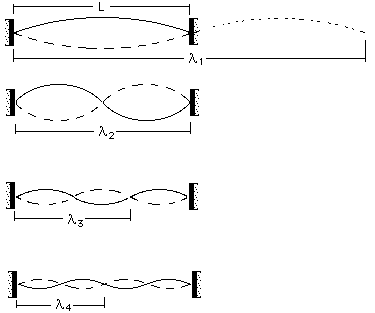1. Simulate a single pulse wave that is reflected back to the starting point with the same sign and amplitude as it was generated.
2. Simulate a single pulse wave that is reflected back with the OPPOSITE sign but same amplitude.
Standing waves result when a wave train is reflected back and CONSTRUCTUVE INTERFERENCE occurs between a forward-going and backward-going wave, making the amplitude TWICE as large as the original at the locations called antinodes. Try to generate a standing wave in fundamental mode...that is with one antinode and two nodes, one at either end. For a standing wave, the wavelength is given by &lambda = 2L/n where L is the string length and n is the harmonic number. (Hint: try using a somewhat low amplitude, and set damping =1 for all these trials. Be sure to hit reset after changing parameters.)
Next, without playing, try to predict the needed frequency to generate a standing wave that is the second harmonic (first overtone) with two anti-nodes. And third harmonic (second overtone)!! Then try your guess and try to produce these waves.

Hints: try low amplitude, and frequency=7 or 8 to start with, and highest tension with 0 or 1 damping.